Description of the spikes. Rose hips - photos and recipes for various diseases
Rose hip(lat. Rosa) is a genus of wild plants of the Rosaceae family. It has many cultural forms, bred under the general name Rose. At the moment, more than 350 species are known (according to other sources, 150-250). Usually erect shrubs, less often vines, sometimes low tree-like forms or almost herbaceous plants.
The stems and branches usually have thorns (hence the name).
The leaves of most species are imparipinnate, with paired stipules (very rarely simple and without stipules), contain 5-7 leaflets, deciduous, less often evergreen.
The flowers are solitary, sometimes two or several, usually pale pink, 4-6 cm in diameter. There are forms with flowers that show signs of doubleness. Flowering usually occurs in May - June.
The fruit is oval or ovoid-spherical, red, orange, purple-red when ripe. The color is due to the high content of carotenes. Many types of rose hips contain large amounts of vitamin C, which makes them valuable for medicine and healthy nutrition. The fruits usually ripen in September-October.
Vitamins and bioactive substances in rose hips: vitamin P (rutin), B1, B., K, carotene, vitamin E in seeds. In addition, the fruits contain flavonol glycosides kaempferol and quercetin, sugars - up to 18%, tannins - up to 4.5%, pectins - 3.7%, organic acids: citric acid - up to 2%, malic acid - up to 1.8%, etc.; lycopene, rubixanthin, essential oil, a significant amount of potassium salts, leading microelements - iron, manganese, phosphorus, calcium, magnesium.
Rose hips contain approximately 10 times more ascorbic acid (1.2 g/100 g) than blackcurrants, and 50 times more than lemons. Rose hips have phytoncidal and powerful bactericidal properties. Contains a large amount of antioxidants.
Tinctures, syrups, and decoctions of rose hips are used in medicine for liver diseases, vitamin deficiencies, colds and many other diseases.
Harvesting rose hips
The fruits are collected during their ripeness, when they acquire an orange-red color, from late August - early September until frost; It should be collected carefully, by hand, in tarpaulin or other mittens, directly from the bush, and only whole bright red, unspoiled fruits, when they are still hard, trying not to crush them. Overripe fruits become juicy, soft and harder to pick. Freshly picked fruits must be dried immediately.
The fruits are dried in well-heated ovens, on iron sheets or nets. To dry a large number of berries, nets with berries are placed on bricks in 2-3 rows, but it is necessary to ensure that air has free access to all the berries and that the berries do not burn. They can be dried in fruit and vegetable dryers at a temperature of 80-90 ° C, and in the southern regions - in the sun. Dry rose hips are orange-red, taste sour-sweet, odorless.
If you have a summer house and want to grow rose hips, then it is better to plant it in the fall. And for normal fruiting, it is better to plant two or three types of rose hips that bloom at the same time. Rose hips begin to bear fruit after 3-4 years. The fruits can be dried, and in winter, brewed and drunk 1-2 glasses a day as a multivitamin drink.
Use of rose hips
Infusions from rosehip roots and fruits have long been used in folk medicine in cases of liver and gastrointestinal tract diseases. For stomach catarrh (gastritis) with reduced acidity, use an infusion of 3 tablespoons of rose hips per 1 liter of water, 1/2 cup 3 times a day.
Rose hips are a multivitamin with a predominance of vitamin C - ascorbic acid; they have phytoncidal and powerful bactericidal properties.
In Chinese medicine, rose hip root is used as a remedy that improves digestion and as an anthelmintic. In Tibetan medicine, the fruits are used to treat pulmonary tuberculosis, neurasthenia, and atherosclerosis.
Cinnamon rosehip flower petals, chewed or boiled, are used for arrhythmias to strengthen the heart muscle.
Infused delicate rosehip petals produce rose aromatic water. Popular in cosmetology.
Rosehip oil or oil extract is a derivative whose therapeutic effect is predetermined by the complex of vitamins contained in the fruit. It has a general strengthening effect, enhances tissue regeneration and hormone synthesis, takes part in carbohydrate and mineral metabolism, and has anti-inflammatory and immunostimulating properties. It is often used externally for trophic ulcers, some diseases of the skin and mucous membranes.
Rose hips are used in the form of infusion, syrup, extract, powder, in the treatment of diseases caused by a lack of vitamin C and some other vitamins in the body. Rose hips are useful for patients with diabetes to enhance physical and mental performance, relieve fatigue, and overwork.
The drink obtained by steaming rosehip leaves improves gastric motility, and a decoction of the roots is used as an astringent and tonic for gastrointestinal diseases, kidney and gallstone disease. Rosehip seed oil is used as a choleretic, diuretic and anti-inflammatory agent.
The liver will be much healthier if you drink a decoction of rose hips in monthly courses several times a year.
Preparing rose hips
vitamin infusion
 Pour 20-25 g of rose hips into 500 ml. boiling water (you can use a thermos). Let it brew. Take 100 ml. half an hour before meals, 2 times a day (be sure to strain before use). Store the prepared rosehip infusion for no more than 2 days.
Pour 20-25 g of rose hips into 500 ml. boiling water (you can use a thermos). Let it brew. Take 100 ml. half an hour before meals, 2 times a day (be sure to strain before use). Store the prepared rosehip infusion for no more than 2 days.
Dried rosehip decoction
- 100g dried rose hips,
- 1 liter of water,
- 5-10g honey (sugar).
Crush the fruits, remove the separated hairs, pour the rest with water, boil in a sealed container for 5-7 minutes, let it brew for 2-3 hours, strain through several layers of gauze. To improve the taste and healing qualities, honey is added.
Rosehip decoction with lemon juice
- 20 g dried rose hips,
- 20 ml lemon juice,
- 150 ml water.
Rinse the fruits, add hot water and boil for 10 minutes. Let it brew and strain. You can add 1 teaspoon of sugar. Pour in lemon juice.
Rose hip syrup
- 1 kg rose hips,
- 1kg sugar,
- 6 glasses of water.
Rinse fresh fruits, separated from seeds, thoroughly in cold water, then remove hairs and grind in a meat grinder. Pour water and boil for 10 minutes, add sugar and continue cooking for 15-20 minutes. Strain through a sieve and bottle.
Rosehip drink with blueberries
- 3 tbsp. dried rose hips,
- 1 tbsp. dried blueberries,
- 3 tbsp. honey,
- 5 glasses of water.
Mix crushed dry rose hips and blueberries, add boiling water, leave for 15-20 minutes. Strain the broth. Pour boiling water over the pomace again. Combine both decoctions and add honey.
Vitamin teas:
- Rose hips and black currants (can be dried) are brewed as tea.
- Brew equal parts of rose hips and rowan fruits (they can be frozen first).
Rose hip wine
- rose hips - 1 kg,
- sugar - 1 kg,
- water - Z l.
Thoroughly clean ripe, unfrozen rose hips and rinse in water. Remove the seeds and pour into a 5 liter jar, fill with chilled sugar syrup. Cover the jar with a loose cloth and place in a warm place for 3 months. Shake the jar from time to time. After 3 months, strain the juice, pour it into bottles, seal tightly and place in the basement or in a box with sand. The longer the wine sits, the tastier and stronger it is.
Rosehip marshmallow
Rub 5 kg of rose hips, cleared of seeds, add 4 kg of granulated sugar and 5 fresh egg whites. Beat the mixture in a blender. The whipped mass should be foamy, loose and should not spread. The mass is transferred to flat glass baking trays, placed in the oven and dried for 20 minutes, allowed to cool and sprinkled with powdered sugar. This delicacy will delight you all winter.
Treatment with rose hips (traditional medicine):
1. For chronic hepatitis of various etiologies, take 0.5 tablespoon of rosehip roots and the same amount of barberry roots and pour 0.5 liters of boiling water. Boil for 15 minutes over low heat (preferably in a water bath for 30 minutes). Take 100 g before meals.
2. For heavy menstruation, it is advised to take a decoction: take knotweed - 20 g, cinquefoil - 40 g, yarrow -20 g, rose hips (fruits) -20 g, oak (bark) - 20 g. Take 1 glass of decoction 3 - 4 times a day.
Wild roses , called wild roses, grow naturally in the warm and temperate climate of the Northern Hemisphere.
These are mainly shrubs up to 2 m tall with slightly drooping or erect branches. There are species with very long shoots that cling to the trunks and branches of neighboring plants or creep along the ground. Some rose hips grow in the form of dense, low bushes - pillows, decorative during the flowering period.
Rosehip leaves odd-pinnate, with ovate or elliptical, sharply serrated leaves, with 2 stipules, partly adherent to the base of the petiole. Rosehip flowers are fragrant, large, single or collected in inflorescences.
The flowers are up to 12 cm in diameter. The corolla is formed by 5 petals of red, pink, dark crimson, yellow, and white colors. Rose hips have many stamens, and pistils are also numerous. Sometimes wild roses have flowers with more than 5 petals. So, the rosehip produces double or semi-double flowers. Double flowers are larger and much more decorative than simple ones.
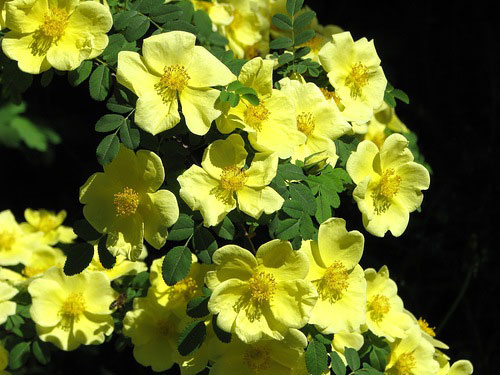
Most of rosehip species in the temperate and cold zones it blooms for a short time - from May to July. Subtropical wild roses bloom continuously. The fruits ripen in August, gradually acquiring a yellow, red color and remain on the branches until winter.
widely used in green construction and in the creation of soil-protective plantings. Undemanding to soil conditions. Most species are photophilous and grow well on loamy soils.

Rose hips reproduce by seeds and vegetatively. Garden forms are propagated by dividing the bush, layering, suckers, root and stem cuttings, cultivated roses by grafting.
They gave rise to more than 200 thousand varieties of beautiful roses, living on Earth for 40 million years. But wild roses are not inferior in beauty and aroma to cultivated garden varieties. Wild roses deserve wide distribution in the landscaping of our gardens.
Among the wide variety of ornamental plants, wild roses are very popular. Rosehip is one of the most ancient crops. It has been grown since ancient times.
A wide variety of varieties and hybrids are quite widely used in gardening. Shrub and standard roses - for flower beds, in the foreground in group planting; climbing types of roses - for vertical gardening. The variety of colors and different flowering periods allow you to create decorative compositions from roses.

Rose hips are also valued for their fruits. Bright rose hips are not only an autumn and winter decoration for gardens, but also a natural medicine and a useful food supplement.
Rose hips contain vitamins and minerals necessary for humans. Rose hips contain carotene, rutin, iron, phosphorus, manganese, magnesium, potassium, as well as antioxidants and organic acids.
Eating rose hips , strengthens the immune system, increases the body's resistance to the effects of bacteria, and helps slow down the aging process.
Rose hips are unpretentious to the soil, and rose hip species from temperate latitudes are distinguished by their high winter hardiness. This determined the use of rosehip as a rootstock for its overly tender and sickly descendants. In particular, dog rose is widely used for this purpose.
May rosehip
IN middle lane In Russia, the most common type of rosehip is May. Its bushes can be found in forest clearings and clearings. But most often it grows in floodplains, where it forms large thickets. In May, the rose hips are covered with large, bright pink flowers for a couple of weeks, and by August they turn orange, and then turn red with ripened fruits. May rose hip plants are quite variable. The shrub can reach up to 3 m in height, or be significantly lower.
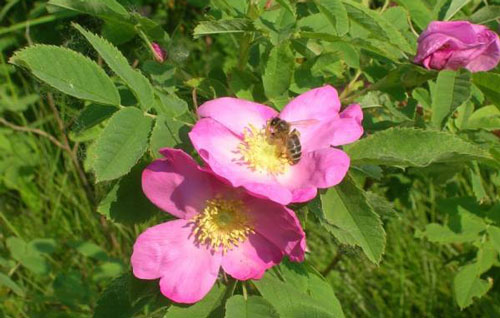
The shape of the May rose hips is also variable - from very elongated to round or slightly flattened. The characteristic distinguishing features of the May rose hips are covered with needle-like spines at the base of the table, as well as small, curved spines on flowering shoots. This rose hip has entire sepals.
Rosehip wrinkled
IN natural conditions grows on the Pacific coast of the Far East, in Korea. On the shore Baltic Sea This rosehip forms dense thickets, but the creeping form predominates here.
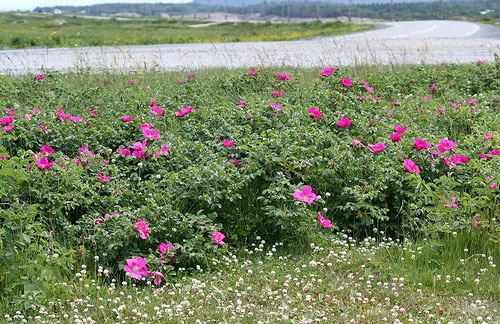
In addition to the bright large flowers that appear on the wrinkled rosehip all summer, it is very beautiful in the fall with its orange leaves and orange-red, flattened fruits.
Dog rose
This rose hip can be seen in the black earth zone of the European part of Russia, around railways, in various disturbed places where the plant ends up escaping from the garden crop. It is cultivated very widely. Dogrose is the most common rootstock for garden roses. Flower growers love it for its unpretentiousness and winter hardiness.
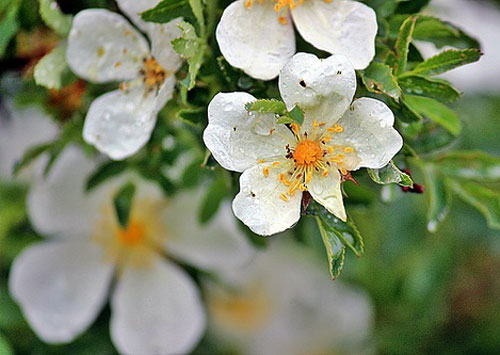
In nature, it is a tall shrub, up to 3 m high, forming a dense, powerful, spreading bush with thick stems. The thorns on the trunks and side shoots are sparsely spaced. Dog rose flowers are pale pink, almost white, the fruits are elongated or round.
Apple rose hips
The rose hip got its name from its fruits - round, about the size of a small wild apple, initially turning yellow and gradually browning on one side. Apple rose hips often grow in the south of Russia, but sometimes freeze over in winter, and in early summer it produces many young shoots from the base of the bush.
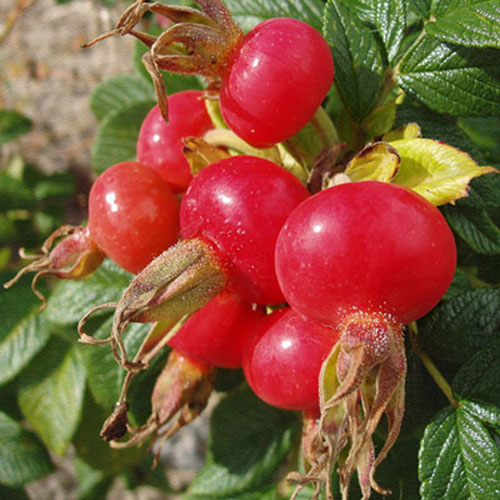
In general, we can talk about rose hips for a long time. We sometimes treat these thorny bushes with disdain, so far from their garden descendants. We must not forget that rose hips are not only a source of medicinal substances, not only a great source of variability for creating beautiful varieties of cultivated roses.
After all ancient legend was invented by the Greeks not about a rose, but only about a rosehip bush. And when you look at the English royal coat of arms, preserved from the medieval War of the White and Scarlet Roses, you will see not a garden rose, but a rose hip flower.
One of the very common plants that has incredible benefits for the body is rose hips; we will look at a photo and description of the plant in the article. Grandmother's tea based on this plant healed many of us from colds and flu in childhood. No wonder. After all, the red berries of wild roses are endowed with a huge number of beneficial properties and vitamins.
What does the plant look like? Rosehip belongs to the rose family, grows in the form of a bush with rather sharp thorns and oval leaves of a rich green color. The bush blooms in summer. Most often, the inflorescences are pale pink with small rounded petals. The fruits ripen in late summer or the first half of autumn.
Types of rose hips with photos
Rosehip officinalis or common has great benefits. In nature, there are the following varieties of plants.
Black
Black rosehip differs from its relatives in the unusual dark shade of its fruit. The berries contain components such as a large amount of ascorbic acid, thiamine, saturated acids, vitamins and many other substances.
The fruits of the plant are used to treat the cardiovascular system, colds, various inflammatory ailments of internal organs and many other diseases.

May
Rosehip May is another type of rose bush, also called cinnamon rosehip. Berries of this type are rich in vitamin C, B, K and many others. In addition, the composition includes saturated acids, pectin, as well as microelements such as calcium, manganese, potassium, and phosphorus.
Recipes based on the fruits of this variety have beneficial properties for pathologies such as diseases of the kidneys, gall bladder, liver, and stomach. Often, decoctions and teas are used for hepatitis and nephritis.

Wrinkly
Wrinkled rosehip has large berries, up to 3 centimeters in size. This type is widely used both in medicine and in cooking. In addition to the fruits, rosehip leaves and flowers are used. Based on them, aromatic vitamin tea is prepared for the treatment and prevention of many diseases.
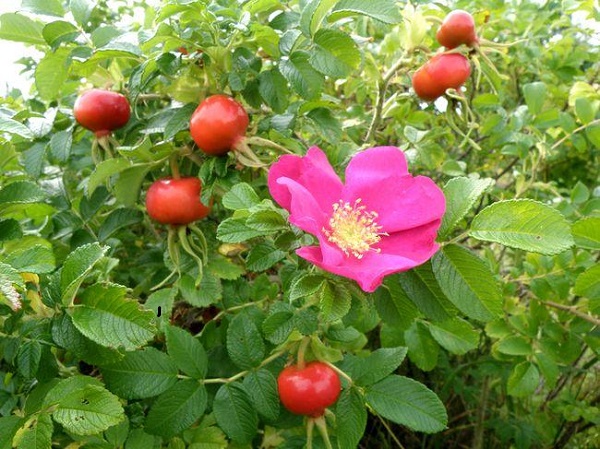
Garden
Garden rose hips, another name for decorative rose hips, can often be found in the garden and dacha of many housewives. The bush is a wonderful decoration, as well as an indispensable medicine. It is worth noting that for the preparation of many products, not only berries and leaves are used, but even the roots of the plant.
The bush blooms with flowers of a delicate pink hue with a delicate aroma.

Wild
In nature you can often find wild rose hips, also called wild rose hips. Despite the fact that the berries of the plant are small and the flowers are not very attractive, this variety is not inferior in its beneficial properties other types.
The fruits are used to prepare aromatic restorative tea, as well as in the form of decoctions for gargling and wound healing.

Canine
Often inexperienced housewives confuse dog rose with hawthorn. What is the difference between hawthorn and rosehip? Externally, the fruits of these two plants are really similar. You can tell them apart by opening the berries. The hawthorn has a hard seed inside, surrounded by pulp; the rose hip has a seed box.
This variety has anti-inflammatory, disinfecting, and wound-healing properties.

Spiny
Rosehip needle is another type of unusually useful shrub. Distinctive feature The plant is characterized by a large presence of thorns located very close to each other.
Medicinal properties include disinfection of wounds, the ability to relieve inflammation, strengthen the immune system and much more.
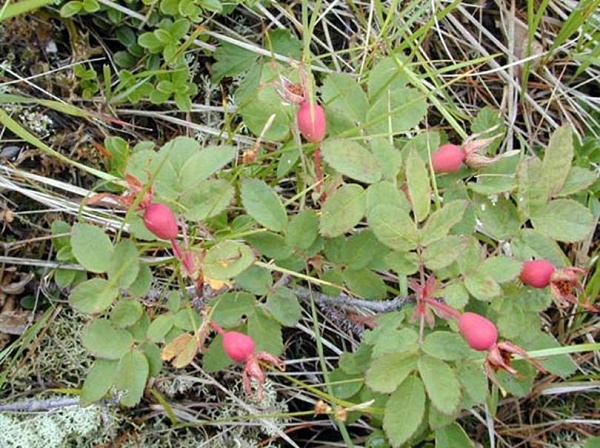
Apple
Apple rose hips received this unusual name because of the similarity of the fruits to small red apples.
The plant contains a large amount of vitamins, minerals, saturated acids, as well as microelements necessary for the body.
Also worth noting are varieties such as white rosehip and terry. All of them are healthy and help strengthen the body and increase resistance to many diseases.
Important! The amount of vitamin C in the fruits of the bush exceeds its content in products such as lemon and black currant.

Composition and use of rose hips
The composition of wild rose includes the following components:
- ascorbic acid;
- flavonoids;
- useful acids;
- tannins;
- sucrose;
- cellulose;
- minerals and trace elements.
Often, when treating wild roses, patients wonder which rosehip is healthier: round or oblong? It is impossible to give a definite answer to this question. Different varieties of plants are useful in their own ways.
The beneficial properties of rosehip are as follows:
- The fruits of the bush are indispensable for blood diseases, as well as for cleansing the body of waste and toxins. A decoction of berries normalizes blood pressure and cholesterol levels.
- During epidemics of colds, red fruits have an excellent immunomodulatory and restorative effect.
- Rosehip roots are used as a good astringent.
- Diuretic and choleretic effects provide the possibility of treating pathologies of the kidneys, liver and pancreas.
- The ripe product is brewed as a tea to treat coughs, bronchitis and bronchial asthma.
In addition, aromatic tea with fruits and leaves can have a calming effect. It is recommended to take it for severe fatigue, sleep disturbances, nervousness, stress and other disorders of the central nervous system.
Important! Due to the large amount of vitamin C, wild rose berries should be used carefully by patients with high stomach acidity and dental diseases.
Recipes
The use of raw materials is very diverse. We propose to consider several popular remedies for the treatment of certain ailments.
Cough collection
To soften a strong dry cough and improve expectoration, the following medicine is recommended: take 2 tablespoons of crushed wild rose fruits, marshmallow root, licorice, and coltsfoot herb. Mix the products thoroughly and brew with a liter of boiling water. After cooling, take 2-3 glasses per day. You can add honey or sugar for taste.

Stomach treatment
For intestinal disorders, excessive gas formation and other dyspeptic disorders, experts recommend the following remedy: pour a tablespoon of crushed berries into a glass of boiling water and leave to brew for 12 hours. After this, the medicine is filtered and taken 30 ml three times throughout the day. The course of treatment is 10-12 days.
For inflammatory diseases of the genitourinary system
For various inflammations of the kidneys and urinary organs, you should drink a decoction of red fruits and leaves of the plant. To do this, berries and crushed dry leaves are poured with water in a ratio of 1:3 and the medicine is placed in a water bath. Simmer the product over low heat for 30 minutes. After this, the drink is taken 2 tablespoons three times a day.
To strengthen the body during the cold season, it is recommended to drink aromatic vitamin tea. The drink will perfectly boost your immunity and help you cope with colds and flu faster.
Nature has given us many useful gifts, use them with pleasure and be healthy!
More than 50 species of rose hips and a large number of varieties grow in Russia and the CIS. The most interesting from a medical point of view and containing a larger amount of useful substances and vitamins are the following - w. May (R. Majalis or R. Cinnamomea), w. spiny (R. acicularis), w. cinnamon (R. cinnamomea), w. wrinkled (R. rugosa), w. Daurian (R. Davurica), sh. Webba (R. Webbiana) - rose family (Rosaceae). Rosehip is the ancestor of all types of cultivated roses. Distributed in almost the entire European part of Russia, in Western and Eastern Siberia to Baikal. It grows along river banks, in forests, between bushes, along forest edges, clearings, clearings and ravines.
In Ancient Rus' they called it “sworoborin tree” or “svoroborina”, that is, strewn with thorns (sworob - scabies). Dog-rose fruit were issued with special permission only to noble persons. Special expeditions were sent to the Orenburg steppes to collect its flowers and fruits. Russian healers were the first to use rosehip paste to treat wounds. Under Ivan the Terrible, peasants and monastery residents carried out labor duties, collecting and giving flowers and fruits to the treasury. In Russia 14-16 centuries. Gradually, from a remedy that was available only to noble people, rosehip turns into a common medicinal plant.
A shrub, highly branched, up to 2 m high. With branches covered with brown-red bark, with flattened, somewhat curved thorns, sitting at the base of the leaf cuttings. The leaves are alternate, odd-pinnate, glabrous, ovate, with 5 - 7 leaflets, gray-green below. The flowers are five-petaled, pink or white. The fruits are brown-red, ellipsoidal, on the outer convex side with long, appressed hairs, smooth. The appearance of the plant may vary slightly depending on the species. Blooms in May - July. The fruits are false and ripen in August - September.
Rose hip is a multivitamin plant; its fruits are significantly superior to other plants in terms of the quantitative content and variety of vitamins. A water infusion of fruits increases the body's resistance to infectious diseases, weakens the development of atherosclerosis and has a general strengthening, tonic effect. The infusion of the fruit weakens and stops bleeding, reduces the permeability and fragility of blood capillaries. It also enhances the regeneration processes of soft and bone tissues and accelerates the healing of wounds, burns and frostbite. An infusion of fruits is also taken for stomach and intestinal ulcers, catarrh of the stomach with low acidity, and for diseases of the liver, kidneys and bladder.
The taste of the fruit is sweetish, this is caused by sugars: fructose, galactose, arabinose, xylose. In addition to vitamin C (in high-vitamin varieties its amount is 10 times greater than in black currants), the fruits contain numerous carotenoids - precursors of vitamin A, vitamin E, P, B1, B2, K, iron salts, manganese, phosphorus, magnesium. The sourness of fruits is due to the presence of a variety of organic acids in them, including salicylic, gallic, caffeic, vanillic and others. The fruits also contain pectins (up to 4%). The list and amount of beneficial substances of rose hips depends on its variety.
Tibetan medicine values rose hips. It was prescribed for pulmonary tuberculosis, rheumatism, atherosclerosis, neurasthenia, kidney disease, liver disease, stomach disease, infections, burns, and neoplasms. In the main treatise of Tibetan medicine, “Zhud-shi,” rose hips are classified as “means of protection against herbal poisons and means of suppressing them,” as well as “warriors who generally defeat diseases from poisons.” The detoxifying properties of rose hips are even more important these days, when we daily encounter toxic substances in industry, everyday life, insecticides, preservatives, and medications.
Rose hips are picked before full ripeness, when they are still hard but have a colored shell (fruits thawed after frost lose a significant part of their vitamins). They are dried immediately after collection - first dried in the shade, and then dried in the oven at a temperature of 80 degrees. Well-dried rose hips should retain their natural color and smell and not stick together when compressed into a ball.
Rosehip seeds, located inside the fruit, have choleretic, diuretic and anti-inflammatory effects. Rosehip seed oil is not inferior in its effectiveness to sea buckthorn oil as a local remedy for wound healing, stomatitis and gingivitis.
A decoction of the roots has astringent, choleretic and antiseptic properties. This is an excellent remedy for gallstone disease, not only promoting the removal of stones, but also preventing their further formation. The roots are harvested in the fall, chopping immediately after collection before drying.
An infusion of leaves is used in folk medicine as an antimicrobial and analgesic for gastrointestinal diseases. The leaves are harvested during the summer.
Rosehip flowers are also used in herbal medicine. For example, to strengthen the heart. The petals are collected during flowering in dry weather and dried in the shade at a temperature not exceeding 35 degrees.
Recipes for using rose hips
Kidney stones, cholelithiasis, urolithiasis, stones in the prostate and other organs. The skin of the berries painlessly crushes and removes stones from the kidneys, urinary and gall bladder. It is advisable to dry them more for the winter. This is done like this: cut the fruits in half, remove seeds and hairs. Dry outdoors, protecting from sun, rain and insects. Pour 3 tablespoons of boiling water and leave. Drink in divided portions for two weeks. On the third day, reduce the dose by half and drink in sips per day in 45 doses. This way you can crush and remove stones quite easily. The course of treatment is 3 weeks, it should be carried out every season. (You can drink a glass 3 times a day - it all depends on how many stones you have accumulated.) Rosehip roots are also excellent for removing stones. In order to prepare the decoction, you need to take 2 tablespoons of crushed raw materials, pour 2 cups of boiling water, cook for 15 minutes.
Swollen joints. Pour 5 full tablespoons of rosehip flowers into 0.5 liters of table vinegar. First leave for 24 hours, then bring to a boil and cook for 5 minutes. The composition is ready. Lubricate the joints for a few days, and the swelling will go away (but it’s unlikely to cure it - then other remedies will be needed).
For hepatitis, a simple decoction, tea or rosehip jelly is suitable. To prepare the decoction, boil 2 teaspoons of crushed fruits per 1 cup of boiling water for 10 minutes and take ½ cup 2 times a day.
Exhaustion, dystrophy, asthenia, severe weakness. Mix 2 coffee cups of ground fruits, a coffee cup each of St. John's wort flowers, yarrow, 300 g of butter, 600 g of honey. Pre-melt the butter and honey in a water bath, add herbal powders and stir. Take 12 teaspoons every hour.
For heart diseases, a decoction of rosehip roots is very effective. A decoction is made at the rate of 1 tablespoon of crushed root per 1 glass of boiling water. Cook over low heat for 15 minutes. It should be drunk semi-hot, like tea. The daily norm is 3 glasses. You can also use the following collection - mix dry rose hips, red rowan, hawthorn, viburnum, raisins and dried apricots. One glass of the collection is brewed with a liter of boiling water, preferably in a thermos, and left to steep overnight. The infusion is drunk throughout the day instead of tea. Can be taken for a long time.
For paralysis, it is good to use baths with rose hips. The roots of the plant must be chopped into small pieces. For one procedure, 200 g or half a half-liter jar is enough. Cook in 3 liters of water over low heat for 30 - 40 minutes, without bringing to a boil. Remove from heat, leave for 15 minutes, strain, pour into the bath. The bath lasts 20 minutes. The bath should not be hot, no higher than 38 degrees. It is good to alternate such baths with baths on juniper fruits and branches, which are prepared according to the same recipe.
For hypovitaminosis, to increase the body's resistance to adverse external conditions, pour 2 teaspoons of crushed rose hips into 1 cup of boiling water, boil for 10 minutes, strain, take ½ cup 2 times a day.
For a cold, option 1 - mix 2 parts of dried raspberries, 2 parts of rose hips, 1 part of currant leaves. Brew 1 tbsp. spoon the mixture with a glass of boiling water, leave for 15-20 minutes, strain. Drink before bed.
For colds, option 2. 2 parts of rose hips and roots, 2 parts of mint, 1 part of oregano, 1 part of coltsfoot. Brew 3 tsp. mixture with a glass of boiling water, leave in a thermos, strain. Take 1/2 cup 3 times a day an hour before meals.
Febrifuge. Mix 1/4 cup of rose hips and viburnum berries, brew with a glass of boiling water, leave in a thermos or wrap well, strain. Take half a glass every hour or two.
To support a weakened body, you need to mix dry rowan and rosehip fruits in equal parts and brew daily - 1 tablespoon per 1-2 cups of boiling water. Instead of rowan, you can use currants in this recipe.
For anemia, exhaustion, before and after operations, it is recommended to eat fresh rose hips, as well as drink 1/4-1/2 cup of fruit infusion 2-3 times a day.
Contraindications to the use of rose hips
Excessive interest in rose hips is unsafe. It has contraindications for thrombophlebitis, endocarditis - inflammation of the inner lining of the heart, circulatory failure, as well as for skin diseases.
The infusion of berries destroys tooth enamel; every time after it you need to rinse your mouth thoroughly.
A water infusion of berries reduces blood pressure. A decoction of the roots reduces the secretion of bile, can cause constipation, and is contraindicated for hypertension.
Belongs to the Rosaceae family. This multi-stemmed a shrub with an erect or climbing stem, mostly deciduous, although there are also evergreen species (in the subtropics). The length of the stems varies from 15-30 cm to 8-10 m, it all depends on the species. Average duration life from 30 to 50 years. The root is taproot, reaches 5 m. Leaves odd-pinnate, arranged spirally on the stem. Flowers with a diameter of 1.5 to 8 cm are mostly solitary or in paniculate inflorescences, with a very delicate aroma; rose hips bloom in early summer. The fruit is a multi-nut of a special shape, ripens in August-September. It grows on all continents, in zones with temperate and subtropical climates. There are a lot cultivated rosehip forms.
Homeland: temperate and subtropical zones of the Northern Hemisphere.
Flowering: May-June.
Height: 2-3 m.
Light: light-loving.
Temperature: frost-resistant.
Air humidity: not demanding.
Feeding: 3 times per season (spring, June, September).
Transplantation: in the fall.
Reproduction: seeds and root suckers.
Rosehip is a wild form of the well-known cultivated rose (pictured).

It is grown both as an ornamental shrub and as a medicinal plant. Today, about 140 varieties of rose hips are known.
Kinds
- Rosehip brown –
bush up to 2.5 m high, compact, with thin red-brown branches. A very common species with a large number of varieties.
- Brown rose hips are valued for their high content of ascorbic acid and citrine.
- The leaves of the plant are green above and have a grayish tint below.
- Thorns are found mainly on those branches that do not have flower stalks.
- Rosehip flowers have a pink tint.
The berries are red and ripen in August. One bush can produce a yield of 1.3-1.5 kg.
- Rosehip wrinkled -
one of the most common types. The Far East is considered its homeland.
The bush is low, reaches one and a half meters in height.
Name this type received for the unusual shape of the leaves, which are covered with a large number of grooves (pictured).
- Another feature of this species is its long flowering period: the first flowers appear in June, and the bush finishes blooming in autumn.
- Rosehip flowers are wrinkled, bright pink in color and have a pleasant aroma.
For landscaping I use such forms of wrinkled rosehip as terry crimson, terry white, and hybrid forms - grotendorst (pictured above).
One of the greatest advantages of wrinkled rose hips is its winter hardiness.
This is a spreading bush (pictured below) with small leaves and very fragrant flowers that are white or lemon yellow in color.
- The flowering of this species is short-lived and lasts only three weeks.
- Rose hips are black in color.
- England and Scotland are considered the homeland of this species. It was here that up to a hundred different hybrids were bred, differing in the color and structure of the flowers.
- Rose hips are winter-hardy and drought-resistant.
The only drawback of this species is that the root suckers grow a considerable distance from the mother bush, and the planted bush is not so easy to remove later.
- Rosehip red leaf –
neat shrub reaching a height of 2 m.
- There are practically no thorns on the branches, the leaves are bluish-green.
Flowering period is June. The shrub is winter-hardy and drought-resistant.
- Rosehip brilliant –
a low-growing bush with thin brown branches, often studded with thorns.
- The leaves of the plant are small, very shiny, and acquire a reddish tint in the fall.
The flowers are pink, flowering lasts a month and begins in June.
- Dog rose (pictured below) –
- a rather tall, voluminous shrub reaching a height of 3 m.
- The branches are densely strewn with thorns, the leaves are bright green.
- Pink or white flowers are collected in groups of 4-5 pieces.
- IN winter period The bush may freeze, but quickly recovers.
Due to the large number of thorns, it is advisable to plant dog rose in places where there is no possibility of getting caught on it.
- Fragrant rosehip –
a bush of medium height, spreading, with a small number of thorns.
The leaves of this species are very interesting feature: Due to the presence of scent glands on them, the leaves smell like fresh apples.
The variety is mainly used for planting as a hedge.
- Apple rosehip –
a very dense bush, the branches of which are strewn with thorns.
The bush has fairly large leaves, reaching a length of 15 cm. The leaves below are pubescent and have a bluish tint.
The shrub does not bloom for long; the flowers fall off very quickly after blooming.
A bush with ripe large fruits looks decorative.
- Rosehip hugonis –
one of the rare varieties (pictured).
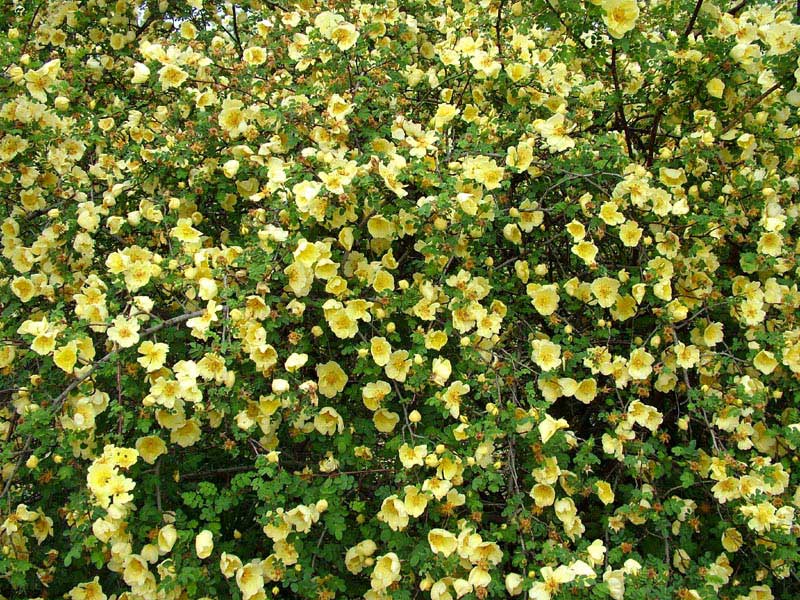
- A very decorative bush with the ends of the branches hanging down.
- During flowering, which occurs in May, the bush is covered with a continuous carpet of rich yellow flowers.
It is very demanding on conditions and care, so this species is quite difficult to grow in the middle zone.
Care
Comprehensive care for rose hips includes watering, fertilizing, pruning the bush and protection from diseases and pests.
Watering rose hips is necessary for the first time after planting. The volume of water for one watering of a seedling is 20 liters.
- Older bushes rarely need watering, except in dry summers.
- Rose hips are quite resistant to drought, so 4-5 waterings may be needed over the entire season.
- To water an adult plant, five buckets of water are enough.
Feeding. In order for the rose hip bush to bloom for a long time and bear fruit abundantly, it is fed three times a season.
Fertilizing begins the next year after planting. Nitrogen fertilizers are used for fertilizing.
- The first time the bush is fed until the buds open;
- The second time the plant is fertilized during the period of intensive growth of young branches (June-July);
- the third feeding that should be done is in September.
When digging up the ground around the bush, you can also add organic fertilizers (compost or humus) at the rate of 3 kg per plant.
Trimming. Very important point plays it for the growth and proper formation of the plant.
The first pruning of the bush is carried out 2-3 years after planting. Up to two dozen branches of various ages are left on the bush.
It is advisable not to leave branches older than 7 years of age; they do not bloom so profusely and practically do not bear fruit.
Pruning is carried out in early spring.
If you want to collect rose hips every year, do not prune too short, otherwise the bush will produce a large number of young shoots that do not bear fruit.
Disease and pest control. Comprehensive care for rose hips also includes the fight against diseases and pests, of which the plant has a lot.

The greatest harm to the bush is caused by the sawfly, gypsy moth, and leaf roller.
If a rose hip is damaged by sawflies, all branches and leaves with eggs laid on them are removed from the bush and burned. Larvae are removed from the bush by spraying, and digging up the soil under the bush before frost will help destroy the cocoons of the pest.
Damages buds, leaves and shoots of rose hips. If clutches of silkworm eggs appear, they are scraped off the branches and destroyed. The branches of the bushes are smeared with kerosene or diesel fuel.
The rose hip aphid (pictured) is also dangerous for rose hips.
The insect damages the buds, sucks the juice from the leaves and buds, preventing the plant from developing and bearing fruit normally. To combat aphids, spray with infusions of tobacco, tomato tops, and laundry soap.
Reproduction
Rosehip reproduces by seeds and root layering.
Seeds. Rose hips are collected in August, when they are not yet fully ripe, and the seeds are extracted from them.
- At this time, the seed coat has not yet completely dried out, and the seeds will germinate faster.
- You can plant seeds in early spring, but it is better to sow in autumn.
- For planting, choose a clear sunny day in early October.
- Rose hips are sown in rows in a prepared fertilized bed and sprinkled with sawdust on top.
- After the snow melts, for better seed germination, you can stretch the film over the arches or over a wooden frame over the bed.
- When the first two leaves appear on the seedlings, they can be transplanted to a permanent place (pictured).
If you decide to plant seeds in spring, they must first be stratified.

